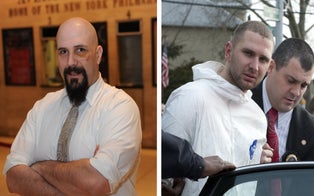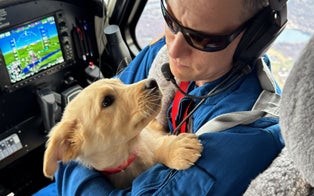Pirates once stormed the high seas of New York City in the 1980s, all with the goal of capturing a booty that couldn’t be seen.
In the summer of 1987, a group of pirates aboard a ship three miles off the coast of Long Island infiltrated the New York City radio airwaves. They hijacked the frequencies in the name of free speech and better music, they said.
In the realm of crimes happening in 1980s New York City, this might seem like a minor infraction, but their actions were highly illegal.
This Is Radio Clash
In the 1980s, New York City radio was a highly influential medium. Not only did the disc jockeys who ran the airwaves have power, but so too did the artists they spun.
“If you got played on the radio, you had a hit. Even though there was less freedom in those days, commercial music radio was still the core of the music culture in the US,” Marty Brooks of the New York Radio Archives told Inside Edition Digital.
While the mainstream radio was playing the hits from records of that year like U2’s “The Joshua Tree,” Paul Simon’s “Graceland” and Bon Jovi’s “Slippery When Wet,” some of the biggest stars of the year, some felt the music selection over the airwaves was bland. But those making the decisions about who or what to play had motivations that extended beyond creativity.
“One of the things that happened in that era is that there had already been a lot of sales of radio stations to bigger companies. And each time a radio station was sold, the debt service went up. And when the debt surface went up, they had to increase advertising revenue,” Brooks said. “In order to increase advertising revenue, you had to appeal to the widest common denominator.”
More radio play meant more albums being bought in stores.
“Any of the radio stations that were in the top 10 or top 15 could break a record. And it certainly made a significant difference because if you got played, people went out and bought that record,” Brooks added. “While there were different formatted radio stations, we were all pretty much listening to the same thing. So people like Madonna or Bruce Springsteen or Michael Jackson, these were big acts for everybody, or almost everybody. And so radio had a tremendous impact.”
But some consumers wanted something more, including those behind Radio Newyork (sic) International, or RNI. RNI was a pirate radio station that wanted to put an end to corporate radio.
“A group of us that wanted to bring free speech radio to the New York City metropolitan area, because remember, at that time, back in the 1980s, getting into the New York City market, you would have needed 30, 40, 50, $60 million to buy an existing AM or FM radio station," Allan Weiner, who orchestrated RNI, told Inside Edition Digital. "So we decided to go another legal route, which was to outfit a ship as a broadcasting ship and put it in international territory, which is about three miles off the coast of Long Island, New York.”
Weiner, a self-described “geek,” loved building radios and had some experience outfitting ships with devices to transmit.
In 1986, he and the members of RNI pooled their money together and bought a ship and spent the whole year outfitting it in a Boston harbor.
Weiner said he had a crew of “crazy old hippies and wild guys" in Boston that helped "build everything, and put the towers up, and all that. It was a very cost-effective thing that we did, because it can cost millions of dollars to outfit a proper ship, but it didn't cost us that. It cost us thousands of dollars to do it.”
Weiner and his team equipped the ship with shortwave transmitters to broadcast, which according to Brooks is "not difficult at all" to broadcast from.
“Shortwave radio is a radio that operates on a different set of frequencies aside from AM and FM. And it's used basically to pick up international radio stations that operate on short wave,” Brooks said.
There was another thing that RNI needed and that was a radio license, which they acquired from Honduras.
“The ship was registered to Honduras, it had a radio license from Honduras and we were completely legal,” Weiner said.
Once the ship was ready to go, Weiner said they lifted their anchors and set sail for the New York area, where he and many of the DJs were from. Once there, they began broadcasting three miles off the coast of Long Island in what he says was international territory.
“Three miles out, that's it. [The FCC] don't have any jurisdiction. Just like they don't have jurisdiction in Canada. They don't have jurisdiction in Mexico. And that's what we did to keep it legal,” he said.
The ship, nicknamed “The Sarah,” made it to its area off the coast of New York's Long Island by July 22, 1987 and sent transmissions from the ship to 103.7 FM, Weiner said. The pirate radio was live.
It didn't take long for listeners to catch on to what they were doing.
“We didn't have cell phones back then. So we really didn't know what was going on,” Weiner said. “We start listening to the radio, to the news stations in New York, and all of a sudden all these news stories, ‘Well, there's a pirate ship off the coast of New York.’ And all this and stuff. And I go, ‘Oh, good. People are listening to us. Great.’”
But things would prove to take a turn.
Combat Rock
In 1987, aside from top 40, the punk sounds of The Ramones, Talking Heads and The Clash, as well as the new wave hits from Depeche Mode, New Order and Erasure were consistently gaining a following. However, other new forms of music were emerging that mainstream radio was not paying attention to, including New York Hardcore and hip-hop.
New York City was the birthplace of hip-hop in 1973, but by the '80s, it was still considered “new” to many listeners and cooperate radio executives. RNI was ready to given any band or emcee a chance that didn't have an outlet.
“We did it to get bands and groups on the air,” Weiner argued. "We were an international territory, and we went on the air. And we were using frequencies that caused no interference, or no harm, and we did it for freedom of speech."
His wife, Angela, who was not part of the pirate radio ship's actions, said her husband and his crew's actions were “the protest of corporate and corporate saying what the public will and won't hear.”
Despite their stance on playing music no one else was putting on the airwaves, the pirates also broadcast the tunes of popular artists like John Lennon, Bob Dylan and even Bon Jovi.
In less than a week at sea, nearly every local news outlet in the New York City area was covering the ship's actions. They also made headlines in New England, where the ship and the crew originated from.
The FCC then became involved, saying it was illegal to broadcast without a license on an unassigned frequency no matter how far out to sea the ship may have been.
“We were on for about four or five days, and then as the old saying goes, the ship hit the fan,” Weiner said.
He said that the Coast Guard boarded the ship one morning with the FBI and “stopped the station.” He said that everyone on board was put in handcuffs, despite protests from the crew that they were in international waters.
Weiner and DJ Ivan Rothstein were taken to Brooklyn and charged in a U.S. District Court on grounds of conspiring to defraud the United States by impeding the functions of the FCC. Their charges were misdemeanors and carried a maximum sentence of five years in prison and $250,000 in fines. They were released without bail and agreed not to resume broadcasting until the case was resolved, UPI reported at the time.
Just over a month after their arrest, the charges against Weiner and Rothstein were dropped.
“No further governmental purpose would be served by pursuing the criminal charges,” U.S. Attorney Andrew Maloney told The New York Times at the time. “By shutting down the illegal station, the FCC achieved what it set out to accomplish. It affirmed that the F.C.C.'s authority to regulate the airwaves extends to offshore broadcasts.''
Weiner said he and his band of radio rebels tried to fight the FCC and U.S. Government in court but ultimately lost the battle.
“We tried to fight it,” he said. “We actually got the American Civil Liberties Union on our side, and we tried to fight it.”
Revolution Rock
While the pirates lasted just five days at sea, the ship went on to a new significant chapter in the 1990s.
Weiner put "The Sarah” in storage in Boston and later sold the ship to MGM pictures, which used it as a prop that they blew up in 1994's “Blown Away,” starring Jeff Bridges and Tommy Lee Jones.
After years of fighting, Weiner eventually got his legal radio license and began taking to the shortwave airways again by founding the station WBCQ in Maine with his wife, Angela.
Angela is proud of what her husband has done, saying, “the fact that someone put passion for other people's ideas, and rights, rarely do you see it put to the task of actually getting a radio ship, building it, putting it on air, believing you've done everything right.”
Today, WBCQ is still live. The Weiners run WBCQ using the same philosophies of the pirate radio. The station even features one of the DJs who was aboard the ship.
“Radio Newyork International is still alive in what we do with WBCQ radio," Weiner said. "We went to shortwave and we transmit all over the world."





